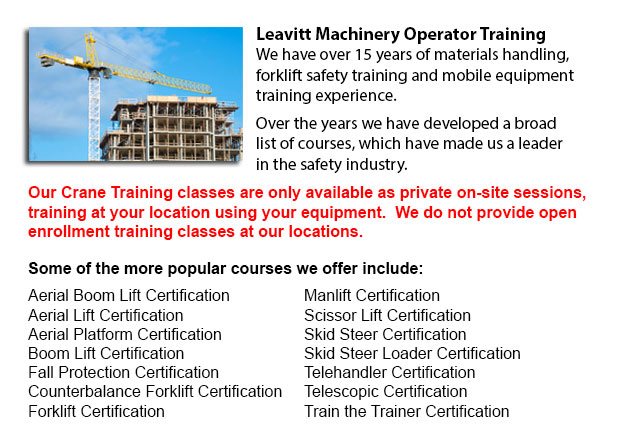
Brampton Overhead Crane Safety Training - Overhead crane safety training equips operators with knowledge and skills regarding crane safety measures, accident avoidance, materials handling, and equipment and stock protection. Trainees will learn the kinds of overhead cranes, their capabilities and their uses in various industry environments. For operators who are licensed and trained, the shift in liability moves from the company to the operator. Therefore, the course emphasizes individual operator responsibilities.
The operators in the overhead safety training course would be given instruction on the right ways for doing inspections: the pre-shift inspection and the more detailed in-depth inspection. These are vital every day routines which should be logged. Correctly recorded pre-shift checks help to protect the company from liability in the event of an accident. Pre-shift checks also prevent accidents, damage and expensive repairs. Operators learn how to designate a particular individual to handle inspections, how to maintain the log book and how to report problems.
Every inspection must be carried out and documented on a regular basis. Things which must be checked for possible concerns, include: hooks for cracks, increases in the throat opening, degree of twist; hoist ropes for corrosion, worn wires, loss of diameter, broken wires, kinks and bird caging, chemical and heat damage; chains for gouges and nicks, twists, cracks and corrosion, excessive wear, distortion, pits, stretching, damage caused by extreme heat.
Operators learn proper rigging methods in this course. Rigging includes understanding the manufacturer's data plate, determining the weight of materials to be lifted, selecting the gear, and utilizing safe practices to secure the load. The course cover in detail the following: safe working loads, and the capacities of chains, ropes, shackles, slings and hooks.
It is important to know who could utilize the cranes at your facility, physical requirements of the job, and operator qualifications required for specialized tasks and permits. Safety is a priority when operating near pedestrian traffic.
The duties involved in the safe crane utilization includes checking for hydraulic leaks, undertaking visual inspections, checking the safety guards, testing the controls, examining the hook and hoist rope, limit switches and braking mechanisms. Proper reporting methods are important. These topics are all covered in depth in the program.
Proper lifting and moving procedures with cranes and hoists are covered in the course. Operators would become knowledgeable in hand signals. Training involves how to attach the load, raise the load, abort a lift, set the load and unhook the slings.
The steps involved with moving the load, includes: starting and stopping procedures, controlling and guiding the load, observing working conditions and working with signals. In the event of power failures, the operator would have to know how to proceed. The program includes techniques for lowering the load and removing the slings, parking the crane, storage equipment, and securing an outdoor and indoor crane.
-
Brampton Aerial Boom Lift Ticket
Brampton Aerial Boom Lift Ticket - Aerial lift trucks might be used to accomplish several different tasks executed in hard to reach aerial places. Many of the tasks associated with this style of jack include performing routine maintenance on building... More -
Brampton Aerial Lift Train the Trainer
Brampton Aerial Lift Train the Trainer - The Aerial Lifts Train the Trainer Certification Program would teach trainers how to efficiently train operators in safe industrial mobile equipment operation. Trainers are provided with in-depth instruction o... More -
Brampton Zoom Boom Training
Brampton Zoom Boom Training - Zoom Boom Training is intended to train operators on variable reach forklifts. The goals of the training are to be able to impart an understanding of the physics of the machinery, and to be able to outline the operator's... More -
Brampton Heavy Equipment Operator Training
Brampton Heavy Equipment Operator Training - Heavy equipment operator training facilities that provide good standards within the industry, providing field performance work and additional machinery training are really sought after training features. S... More -
Narrow Aisle Forklift / Order Picker Training / Electric Pallet Jack / Electric Pallet Truck Training in Brampton
A pallet haul is equipment built in particular for moving pallets of irregular weights and dimensions. They may be used in conjunction with cranes, forklifts and other heavy duty equipment as an appendage piece or to be employed on their own. Pallet... More -
Brampton Crane Safety Training
Brampton Crane Safety Training - Companies and crane drivers have to know the problems associated to crane safety. Legislation provides rules for the safe maintenance, operation and inspection of lifting machines across North America. Crane Safety co... More -
Brampton Telehandler Training
Brampton Telehandler Training - Telescopic handlers normally known as telehandlers for short, are a really popular piece of heavy construction machinery. They are usually utilized in the construction and agricultural trades. These machines have farth... More -
Brampton Aerial Platform Training
Brampton Aerial Platform Training - Aerial lifts can be used to accomplish many distinctive tasks done in hard to reach aerial spaces. Many of the tasks associated with this style of lift include performing regular upkeep on buildings with high ceili... More

Forklift Certification Brampton
TOLL FREE: 1-888-254-6157
Brampton, Ontario
forkliftcertificationbrampton.com
Email Us
About Us


